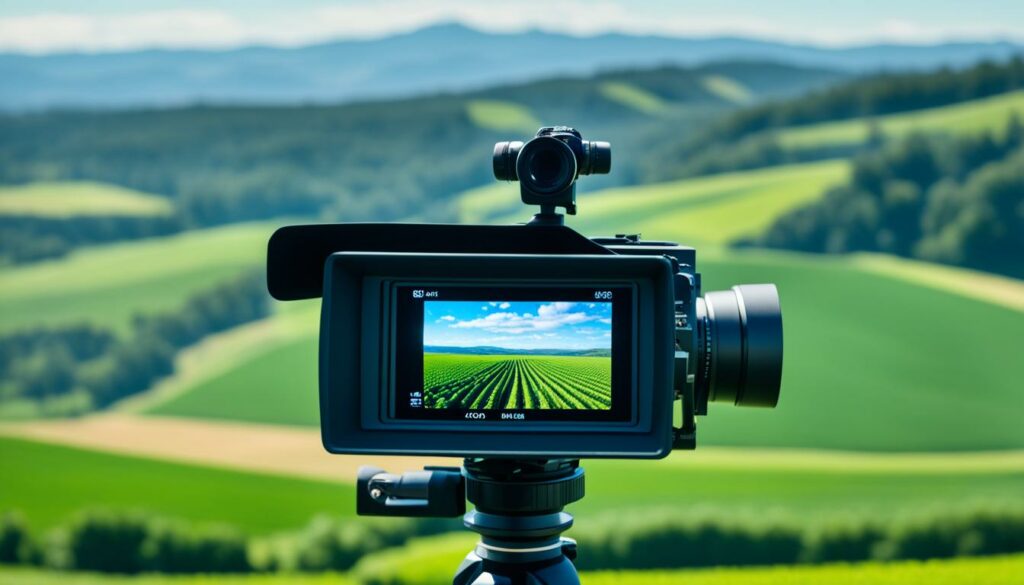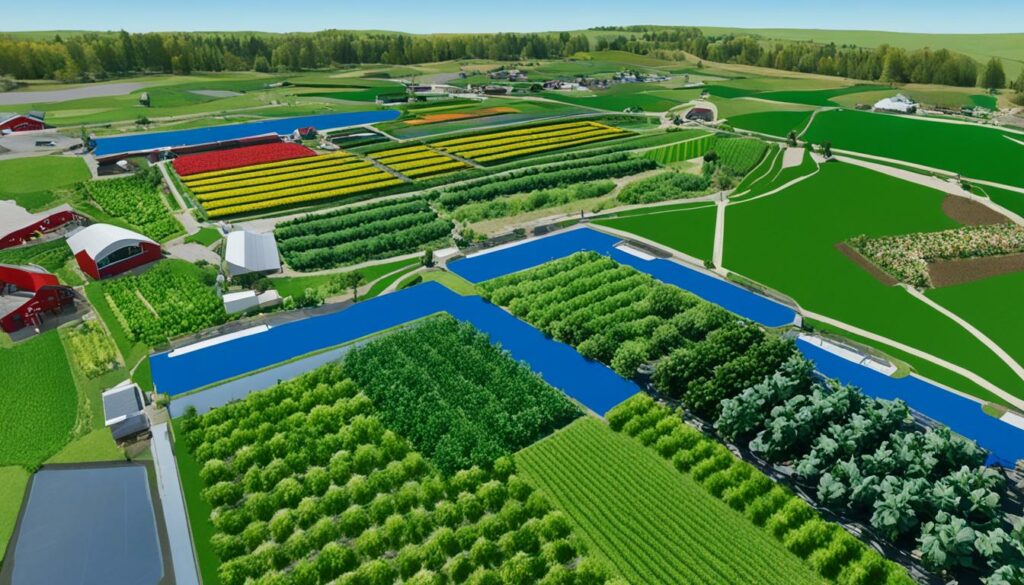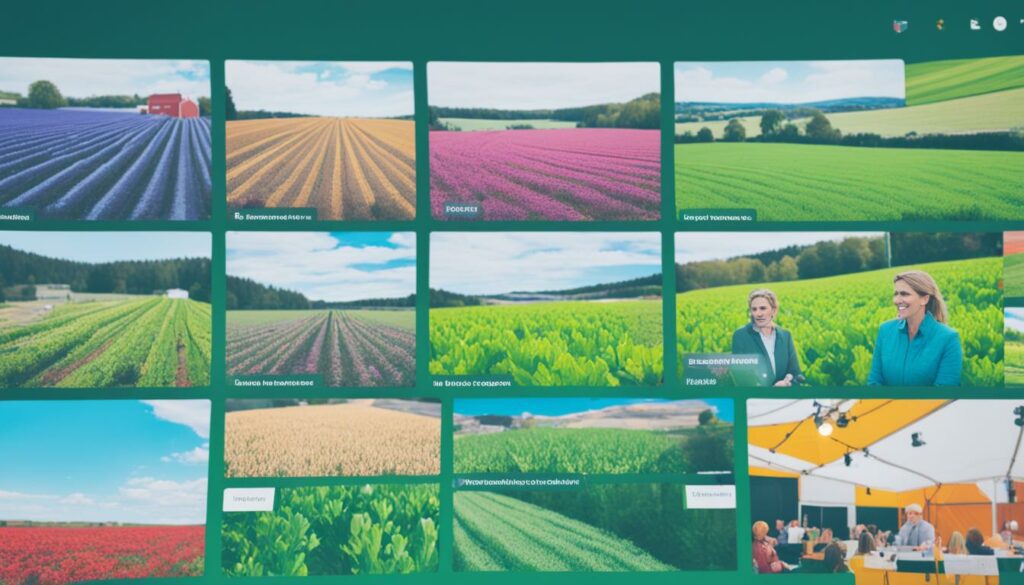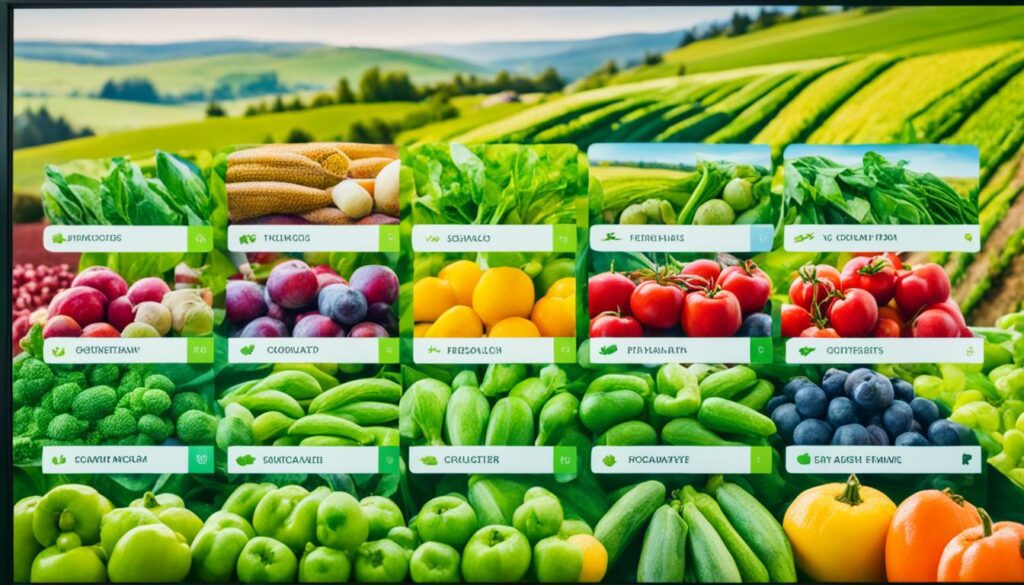Menu

Did you know that in 2020, virtual agritourism events really took off because of COVID-19? This sudden boost showed how important virtual experiences became. They let people from far and wide join in, something they couldn’t do before. These experiences, like virtual farm tours and wine tastings, didn’t just keep businesses alive. They also made their reach bigger, welcoming visitors from everywhere.
Organising online farm visits isn’t simple. It takes a detailed plan to cover the tech and keep everyone interested. Surprisingly, small online meeting rooms often make guests happier than big platforms. The cost of joining these virtual events can change due to tech needs, sending out tasting samples, and who the events are for. Having different prices helps more people take part, from basic deals to VIP treats.
Choosing the right tools for online talks, like webinars, good lights, sound gear, and cameras, is key. A well-prepared plan makes everything run smoother. This means setting goals, practicing before the big day, and listening to what guests thought. These steps boost how much people enjoy and value these digital visitors’ experiences.
Nowadays, agritourism has gone online, calling it virtual agritourism. This means rural life experiences are available through the internet. By using online farm tours and immersive agricultural experiences, farms reach more people than ever before.
Virtual agritourism brings the farm to your screen. Through live streams and interactive tours, you can visit farms from home. Thanks to services like Zoom, Webex, and WebinarJam, you can talk to farmers and see what they do.
The pandemic made virtual agritourism even more popular. It forced a quick change to online events, like online farm tours and classes. This shift was about safety but also opened new doors.
Farms became closer to people everywhere, thanks to tech. Virtual events made it easy for anyone to join, showing clear steps to get there. These events often use cool farm images that make learning fun.
Virtual agritourism experiences became popular during the COVID-19 pandemic. They offer a unique chance to explore the countryside from home. This has made agritourism available to more people than ever before.

Virtual tours break down travel barriers. They welcome visitors from around the world who might not otherwise come. This helps agritourism spots gain more attention and bring in visitors from all walks of life.
Joining a virtual tour is simple from home. This means no need for long journeys and expenses. It allows those with busy lives or physical challenges to enjoy the experience. Furthermore, it’s often cheaper to attend these events virtually, opening them up to a wider audience.
With the pandemic, staying safe is key. Virtual tours offer a way to learn about farming life without risking our health. This shift has not just helped the industry survive but has paved the way for future online farm visits.
Look at how virtual agritourism experiences stack up:
| Pros | Cons |
|---|---|
| Broader geographic reach | Lower interpersonal connections |
| Greater convenience and accessibility | Potential technical issues |
| Enhanced health and safety | Distractions during virtual sessions |
| Potential to inspire future visits |
The trend in virtual agritourism is changing the game. It lets people from all over the world enjoy the countryside, all while keeping safety and convenience a top priority.
Virtual farm visits are very popular. They let people experience farming from home. This new way of visiting farms makes it fun for city folks and people all over the world.
Online farm tours let you see life on a farm up close. You can look at the animals, the crops, and how the farm runs. They let you walk around the farm and talk to the farmers. It’s not only fun but also a great learning experience.
Remote farming experiences are even more hands-on. Now, people can join in farm activities virtually. This includes planting, harvesting, or cooking with farm produce. It makes you feel like you’re right there on the farm. These experiences also help you learn more about farming.
Both virtual farm visits and interactive tours are changing the way we see farming. They mix new tech with old traditions. This not only teaches us but also makes us value farming more.
Virtual agritourism events require the proper tech to work smoothly. This means the best webinar platforms and top-notch video and audio. It’s all about creating a digital world that feels real.
Platforms like Zoom, Webex, and Microsoft Teams play a big role in these events. When picking one, think about how many can join, how long the event will be, and what interactions you want. These tools let people join in live and help run the show well, making your virtual visit top-notch.
Don’t overlook the importance of good lights and sounds. They keep your viewers interested and make the scene come alive. Place lights carefully to avoid dull spots on screen. And good microphones are a must-have to pick up clear, noise-free sound.
A great video camera is key for a professional and engaging event. You need one that captures clear, detailed shots of the farm. This makes your audience feel like they’re really there, watching live.

| Technology | Key Considerations | Benefits |
|---|---|---|
| Webinar Platforms | Participant capacity, event duration, interactive features | Facilitates real-time engagement |
| Lighting Equipment | Proper arrangement to avoid shadows | Enhances video quality |
| Audio Equipment | High-quality microphones to avoid background noise | Ensures clear communication |
| High-Quality Video Cameras | Good resolution and focus capabilities | Provides an immersive experience |
Planning a virtual event needs a clear goal and understanding of online interactions. Our aim is to create engaging virtual tours of farms. Since 2020, online events have grown due to their easy access and comfort.
Online farm tours reach people far and wide and are safe from health issues. They keep the interest in visiting farms alive. Yet, organising them has its hurdles, like lack of direct contact and possible technical problems.
Setting expectations for customers is key. Let them know if they can ask questions and what they might need to buy. Think about the audience size carefully to make each experience special.
Finding the right price is tricky. Think about costs without a physical event and what extra equipment you’ll need. Different packages let you meet various budgets, making the tours accessible to many.
Good tech is a must for a top-notch virtual tour. Use the best webinar tools, lighting, and sound equipment to make a good impression. Unique links for every event can help with sign-ups and avoid mix-ups.
To run virtual farm tours well, make sure to cover time zones and what the tours include. Using videos and photos can make the experience better. Following a detailed plan, doing practice runs, and getting feedback help improve each tour.
Effective marketing strategies for digital farm experiences, like virtual visits, are key. They set the right expectations and show the unique sides of these events. I believe segmenting the audience is vital. This means finding and aiming at specific groups through surveys and data. It helps to send messages that really speak to likely visitors.

Inbound marketing is also important. It involves making useful, on-point content and guiding leads through automation. This attracts and turns interested people into participants. It also lets us check and change our plans always. This way, we get better at turning viewers into visitors.
Real content is crucial for virtual farm tours. Using stories, photos, and videos that show the heart of agritourism sets the right picture and makes people want to come. Reviews and stories from past visitors build trust. They often help people decide to visit.
Telling visitors what’s on offer is very important. Making sure they know about the activities through websites, social media, apps, and brochures helps. Also, making sure your team is always ready to give useful info improves the whole visit.
Don’t forget about local SEO methods. With good keyword planning, content tweaks, faster sites, and more links, farm tour businesses can get more visible online. This is vital for being at the top in local searches.
Influencer marketing can boost reach and interest too. Working with influencers who share your brand’s values can draw in more people. This builds a bigger community around your tours.
Using social media well brings all these strategies together. Places like YouTube, Facebook, and Instagram are great for showing what you do, promoting events, and offering specials. Ads that focus on different groups can help reach specific audiences.
Email marketing is a strong tool that should be used too. Breaking up email lists, making compelling newsletters, and personalising emails with the help of analytics are critical. They help keep returning visitors and bring in new ones.
Lastly, paid ads can work with SEO to broaden reach. Picking the right keywords, making eye-catching ads, choosing the right places to show them, and testing on different platforms can help. Today, many travellers are keen on outdoor activities and cultural trips. This shows good potential for digital farm tours.
The rise of online farm tours opens new doors for agritourism. It connects with people worldwide. These events showcase local farming and reach a global audience. They provide a deep look into the potential of agritourism.
In Scotland, virtual lambing tours have shone brightly. People from all over the world have tuned in. They get to see the engaging process of lambs being born. This online experience overcomes distances.
It shows a key part of Scottish farming without anyone having to travel. Tourists watch as baby lambs start their journey and discover the dedication it takes to look after them.
Virtual lambing tours are a great example of the power of online farm visits. They turn the traditional into something anyone can enjoy from wherever they are.
| Aspect | Virtual Lambing Tours |
|---|---|
| Location | Scotland |
| Key Feature | Real-time viewing of lambing season |
| Audience | International |
| Technology | Webinar platforms, high-quality video cameras |

Interactive agricultural tours are a hit because they let people do more than just look. Participants can meet farmers, ask questions, and get hands-on in the farm work. The chance to truly experience farm life is a big reason why virtual countryside adventures are fun and educational.
Interactive tours are carefully designed to let visitors take part in farm work, even digitally. This makes for a lively, engaging visit.
These tours are also great for learning. For example, knowing about the Minnesota law on agritourism shows how these activities can draw people to farms. They also help with community growth. Making these tours work well needs careful planning, following the law with help from FarmCommons, and good advertising as seen with Minnesota Grown and Explore Minnesota.
In combining learning with fun, interactive agricultural tours help local businesses and farmers earn more. Research shows the agritourism market is growing fast. In 2021, it was worth USD 5.95 billion. By 2030, experts think it’ll grow even more. This shows a big chance for tours that let people visit farms virtually and interactively to do well.
| Benefits | Impact |
|---|---|
| New Revenue Streams | Diversifies farmer income |
| Attracts Visitors | Boosts local business development |
| Educational Value | Increases agricultural knowledge |
| Global Reach | Facilitates cultural exchange |
Social media is key for promoting virtual events, including digital agriculture tours. By using these platforms well, we can share event details and grab people’s interest. This happens through fun and interactive posts.
In 2010, 70% of Americans were on social media. It showed then how vital social media is for promoting virtual events. For instance, Facebook had over 800 million people on it around the world. It made it easy to reach many different people. Also, over 50% of Facebook users checked their accounts daily. This showed they were very interested in these virtual agriculture tours.
Instagram is also very important, especially for digital agriculture tours. It has a billion users and 500 million of them look at stories every day. Businesses find that their stories are often the most popular, which means they can easily connect with people worldwide. This is great for sharing updates, news, and products with followers.
Overall, using social media from Facebook to Instagram is great for these digital tours. It lets us get the word out and attract a big mix of people interested. The way these platforms work keeps people interested in the tours. So, they’re an important part of how we market these modern agritourism events.
Organising virtual farm events is tricky. It involves handling technical glitches and making sure people stay interested. Since tech is more important for farm tours, we must tackle these hurdles for virtual visits to work.

One big obstacle is technical problems. These can differ based on where you are. For example, the West in the U.S. might have trouble with rules, while the South often struggles with internet connections. Having good internet isn’t only about good videos; it also widens a farmer’s audience. To avoid surprises, doing tech tests beforehand is smart. This lets organisers deal with issues early, making the event smoother for all.
Getting people to stay involved in virtual events is hard work. Most farm event planners find it tough to keep things interesting. They use stories and activities to make the event fun and memorable. More than 60% of people who visit farms find these tactics helpful. People also like events that are eco-friendly, which shows the power of good stories. Adding a personal touch can also make guests 15% more satisfied. This makes the event seem more special and engaging for everyone.
To make virtual countryside adventures fun, use videos and farm clips. This lets people see how farmers work every day. It brings farm life to their screens, teaching them about farms.
An interactive part is key. Q&A sessions with farmers give a personal feel. Quizzes and polls also help people think about farming. They make the event a two-way talk, keeping everyone interested.
Make content personal for engaging remote farming fans. Focus on special topics like organic farming or farm-to-table ideas. Highlighting what’s unique about each farm makes the story more interesting to viewers.
For the best immersive agricultural experiences, mix “soft” and “hard” activities. Some will like peaceful things like virtual horse rides. Others will enjoy the excitement of remote-controlled biking. This mix invites a wide range of people to join in.
Add educational stuff to the fun. Workshops and live demos teach about crops and animals. This learning makes the experience richer and lets people value farms more.
Working with local experts and influencers can make the tour even better. They promote the event and add interesting facts. It makes the adventure both fun and learning-filled.
Keeping people engaged needs good planning. Use videos, chats, personalised content, learning bits, and experts. This way, your virtual farm tour will be memorable and interesting for everyone involved.
Setting prices for online agricultural events is a tricky job. You have to match the costs with the value your guests get. Costs include technology, shipping for tasting events, and making sure the online experience is top-notch. It’s smart to have different prices to suit everyone’s budget and needs.
Prices for virtual agritourism can be higher because of added costs. For example, buying video gear and other tech makes events more expensive but better. Shipping food and drinks for tasting classes adds to the cost. So, setting the right price is about covering these extra expenses but also making it worth the guests’ while.

Offering different priced packages can draw in more people. You might have a basic package that lets you join the event and see general info. Then, a VIP package could give you special time with farmers, exclusive stuff, and high-end food and drink samples. This way, you meet the needs of all kinds of customers.
Using platforms like Zoom or GotoWebinar costs money every month. They also have limits on things like how many people can join and how long the event can last. So, picking the right platform is key to a good event. Having good lights, cameras, and sound is also important to make the event feel pro.
It’s key to add learning elements to virtual tours. This makes the experience more valuable and engaging. They should teach a lot and give context to what’s being shown.
Talking about farming in virtual tours is important. It helps people learn more about farming. Studies show that many students don’t know much about farming. Virtual tours help by showing real farming in action.
Using technology in farming education is smart, as shown by Byrd et al. They found that simulators for welding can teach experienced welders more. This is a good use of tech in farming education. Erickson et al. mention that knowing about precision agriculture is good for certain jobs. Virtual tours can show this and get students interested in these jobs.
It’s a great idea to give out educational kits for virtual tours. These kits might have info, fun things to do, and more resources. Baker and Robinson say interactive learning is very good for teaching.
Helpers in learning don’t just stop at theory, says Haskell. Educational kits mix theory and practice. They make virtual tours even better by making learning stick more and being more fun.
Making a virtual agritourism trip smooth is key for a top-notch and engaging event. I do detailed test runs to spot and fix any tech issues early. This prep boosts how info is shared and keeps everything on target with goals.
For a flaw-free virtual agritourism trip, getting ready well is a must. We do test runs to find and solve tech glitches early, making the event smooth and on point. By practicing speeches, checking sound and video, and simulating sessions, the final event feels more pro and fun.
Beforehand, we look closely at who might come, aiming at certain age groups, income levels, and what they like. Knowing this, plus what people from surveys and polls want, helps create a tour they’ll really enjoy. And we don’t forget to check out the competition and the latest farm trends. This mix, along with our tests, makes sure the online tour is smooth and keeps folks interested.
We also look at money matters and what could affect the virtual show. And we set up ways for feedback after the launch, to keep making it better. So, a great online tour is all about the nitty-gritty, knowing the market well, and always paying attention to what visitors want.
Virtual agritourism lets you explore rural life online. It includes activities like farm tours and seeing how things are grown.
The COVID-19 pandemic pushed virtual agritourism into the spotlight. It became a safer way to experience farming without going there in person.
These virtual trips reach people all over. They’re easy to join and address safety worries. So, anyone with an internet connection can take part.
People enjoy online farm tours and getting involved in farming tasks. These let you visit farms and even help with jobs like planting, no matter where you are.
You need good webinar platforms and equipment for sound and video. Professional cameras and the right lighting are key for a great experience.
To plan well, know what your customers want and set clear goals. Pick the right tech and create interesting content. Aim to make your event stand out.
To market your tours well, use social media and email. Also, working with others can help show how special your event is. Talk about the learning and fun it offers.
One great event was the virtual lambing tours in Scotland. People from everywhere could see baby lambs being born. It was a hit, showing the power of local farming to the world.
Hands-on tours let you do more than just look. They offer chances to chat with farmers and learn about their work. This makes the visit really stick in your memory.
Social media is key for spreading the word about your events. It helps to share details and get people excited. Use social platforms well to draw in a big and varied crowd.
Tech problems and keeping people interested are common issues. It’s important to be ready to fix tech issues fast. Using stories and engaging activities can help keep your audience focused.
To make your countryside adventures fun and interesting, use videos and interactive elements. Things like live Q&A sessions can keep your audience involved and enjoying the experience.
Think about the costs of your tech, like cameras. Also consider how you’ll get samples to people. Make prices that suit all budgets to make your event attractive to everyone.
Adding learning to your tours helps make them more meaningful. Give out kits or resources. This way, people not only see but also learn a lot from your tour.
To make your virtual event smooth, prepare well and try things out beforehand. Doing practice runs can fix tech bugs and make sure everything runs as planned.